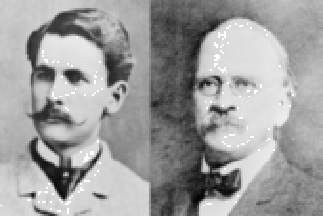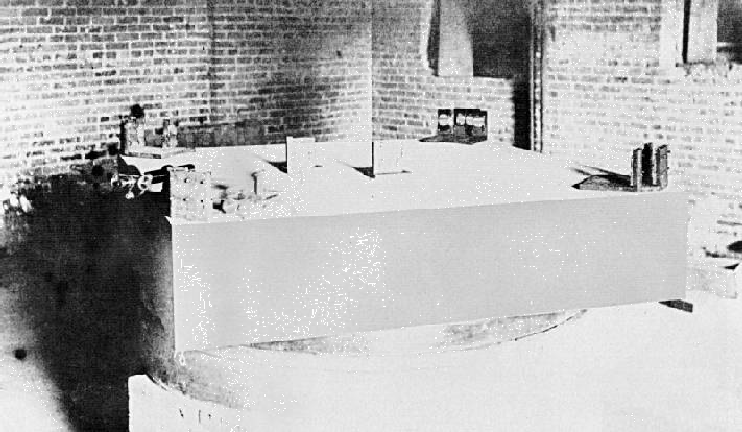Next: The Michelson Morley Experiment: Up: Special Relativity Previous: Special Relativity Contents
The speed of light,
![]() was the central question that gave rise to the theory of relativity.
The speed of light is very large compared to the speeds we experience.
We have no physical intuition about speeds approaching
was the central question that gave rise to the theory of relativity.
The speed of light is very large compared to the speeds we experience.
We have no physical intuition about speeds approaching
![]() .
We can however measure the speed of light with a rotating mirror.
.
We can however measure the speed of light with a rotating mirror.
In what frame is the speed of light
![]() ?
Newton's laws are independent of which inertial frame is chosen.
Is the speed of light going to break this symmetry of physics?
?
Newton's laws are independent of which inertial frame is chosen.
Is the speed of light going to break this symmetry of physics?
Maxwell's equations predict the speed of light from some basic measurements of how fields are produced from charges and currents.

There was a simple way out. There could be one frame in which the medium on which EM waves propagate is at rest. The equations of EM were consistent if the speed of light is constant in one fixed frame. Physicists thought EM waves must propagate in some medium. Physicists postulated the ``ether'' (aether). They thought, space is filled with ``the ether'' in which EM waves propagate at a fixed speed. Ether gave one fixed frame for EM. But experiments, particularly Michelson-Morley disagreed. And we would loose the symmetry found in Newton's laws; ``any inertial frame''.
The ether theory was testable. We should see some velocity of the ether. We should see a seasonal variation. Michelson and Morley set up to be sensitive even to the motion of the earth.
Albert Abraham Michelson (1852-1931) was a German-born U.S. physicist (at Caltech) who established the speed of light as a fundamental constant. He received the 1907 Nobel Prize for Physics. In 1878 Michelson began work on the passion of his life, the measurement of the speed of light. His attempt to measure the effect of the earth's velocity through the supposed ether laid the basis for the theory of relativity. He was the first American scientist to win the Nobel Prize.

Edward Williams Morley (1838-1923) was an American chemist whose reputation as a skilled experimenter attracted the attention of Michelson. In 1887 the pair performed what has come to be known as the Michelson-Morley experiment to measure the motion of the earth through the ether. The figure below shows the Michelson interferometer on a block of granite. A beam of light split, and reflected from two mirrors will interfere.

Oliver Heaviside (1850-1925) was a telegrapher, but deafness forced him to retire and devote himself to investigations of electricity. He became an eccentric recluse, befriended by FitzGerald and (by correspondence) by Hertz. In 1892 he introduced the operational calculus (Laplace transforms) to study transient currents in networks and theoretical aspects of problems in electrical transmission. In 1902, after wireless telegraphy proved effective over long distances, Heaviside theorized that a conducting layer of the atmosphere existed that allows radio waves to follow the Earth's curvature. He invented vector analysis and wrote Maxwell's equations as we know them today. He showed how EM fields transformed to new inertial frames.
Hendrik Antoon Lorentz (1853-1928), a professor of physics at the University of Leiden, sought to explain the origin of light by the oscillations of charged particles inside atoms. Under this assumption, a strong magnetic field would effect the wavelength. The observation of this effect by his pupil, Zeeman, won a Nobel prize for 1902 for the pair. However, the Lorentz theory could not explain the results of the Michelson-Morley experiment. Influenced by the proposal of Fitzgerald, Lorentz arrived at the (approximate) formulas known as the Lorentz transformations to describe the relation of mass, length and time for a moving body. ( Poincare did this more accurately but referred to this as the Lorentz transformation). These equations form the basis for Einstein's special theory of relativity.
George Francis FitzGerald (1851-1901), a professor at Trinity College, Dublin, was the first to suggest that an oscillating electric current would produce radio waves, laying the basis for wireless telegraphy. In 1892 FitzGerald suggested that the results of the Michelson-Morley experiment could be explained by the contraction of a body along its its direction of motion.
Einstein's ``On the Electrodynamics of Moving Bodies'' introduced Special Relativity. Einstein had read Lorentz's book and worked for a few years on the problem. He did not believe there should be one fixed frame.

Albert Einstein (1879-1955) grew up in Munich where his father and his uncle had a small electrical plant and engineering works. Einstein's special theory of relativity, first printed in 1905 with the title "On the Electrodynamics of Moving Bodies" had its beginnings in an essay Einstein wrote at age sixteen. The special theory is often regarded as the capstone of classical electrodynamic theory.
Einstein did not get a Nobel prize for Special Relativity. He got one for contributions to theoretical physics including the photoelectric effect. The committee did not think Special Relativity had been proved correct until the 1940s.
Einstein wanted the speed of light to be the same in every frame.
This would work for E&M equations and the way the fields must transform.
It would agree with experiment.
Einstein did consider experiment but maybe not Michelson Morley.
But
velocity addition didn't make sense to anyone.
How could an observer in an inertial frame moving at
![]() measure light to move at the same speed as we do in our frame at rest?
measure light to move at the same speed as we do in our frame at rest?
In what he called
``The Step'',
Einstein realized that by
discarding the concept of a universal time, the speed of light could be the same in every frame.
In going from one inertial frame to another, both
![]() and
and
![]() transform.
The time is different in different inertial frames of reference.
He derived the previously stated Lorentz transformation from the requirement that the speed of light is the same in every inertial frame.
transform.
The time is different in different inertial frames of reference.
He derived the previously stated Lorentz transformation from the requirement that the speed of light is the same in every inertial frame.
Jim Branson 2012-10-21